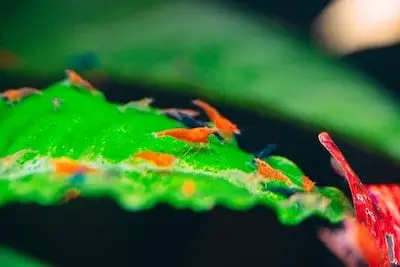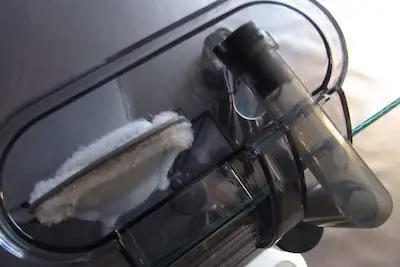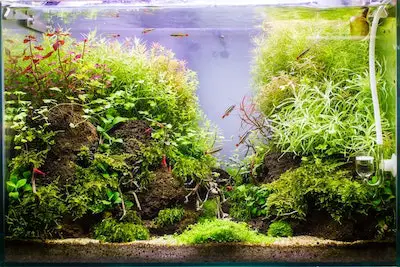Feeding Shrimp Vegetables: Can You Do It?
Your shrimp should have a natural, balanced diet to stay healthy. Since shrimp are omnivores, they can eat various foods, from algae and plant-based supplements to meat and even dead shrimp.
However, when it comes to vegetables, blanched vegetables are best. They’re a great way to give your shrimp the nutrients and vitamins they need to maintain their health.
If you’re wondering whether feeding shrimp vegetables is a good idea, you’ve come to the right place. This article will tell you everything you need to know about the ideal diet for your shrimp.

Contents
Can Shrimp Eat Vegetables?
One of the most important aspects of taking care of shrimp is their diet. A carefully planned, balanced diet promotes growth and reproduction.
In addition, getting a daily dose of nutrients and minerals keeps your shrimp healthy and happy.
If you’re planning to get a shrimp tank soon, it’s good to do your research to ensure your shrimp live in a healthy environment.
Shrimp are omnivores. In other words, they can eat almost anything. This includes dead and living plants, algae, bacteria, other fish, and even dead shrimp from the same tank.
Aquariums with plants are an excellent food source for shrimp, which eat the accumulating biofilm from the leaves, stems, moss, and moss balls.
If your tank doesn’t have any plants, you should replace the biofilm with other supplements. Shrimp also eat the algae that grow in the water, on the tank’s walls, gravel, and other surfaces.
If your tank also has fish, you won’t have to worry about adding supplements to your shrimps’ diet. They’ll also eat any leftover fish food that has fallen to the bottom of the tank.
This means that shrimp enjoy plant-based pellets, granules, and vegetables.
Natural food for shrimp is essential for their health and well-being. Feeding shrimp vegetables is better than pellets and granules because vegetables are much healthier.
It’s also easier to clean up any leftovers from the bottom of the tank. On the other hand, pellets and granules can easily get mixed with gravel.
What Vegetables Do Shrimp Like?
Shrimp enjoy various vegetables, such as cucumbers, broccoli, carrots, kale, zucchini, spinach, peas, etc.
Start with one vegetable and see how your shrimp react to it if you’re unsure.
You will need to prep your veggies before feeding them to your shrimp. There are plenty of ways you can prepare vegetables.
For example, vegetables that have to be peeled, like cucumbers, carrots, and zucchini, need to be washed, peeled and cut into smaller pieces.
Shrimp won’t eat the peel, so you’ll have to remove it yourself.
Like broccoli and spinach, other vegetables need to be separated or cut into smaller pieces.
How Do You Blanch Vegetables for Shrimp?
Blanching vegetables has many benefits. If you’re wondering how to make blanched vegetables for shrimp, it’s the same process as making it for people.
Blanching vegetables means placing them in boiling water to become soft and easy to peel.
It’s a common cooking technique used to prepare vegetables for further cooking. Blanching your veggies also cleans excess dirt and bacteria from their surface.
Some vegetables aren’t soft enough for shrimp to eat, like carrots and zucchini. You can also blanch lettuce and spinach for your shrimp.
Simply fill a pot with water and wait for it to come to a boil. Place the vegetables in the boiling water and wait for a few minutes.
When they become soft, you can remove them from the water. Wait for them to cool, and then cut them into tiny pieces.
Some vegetables need to be blanched longer than others. For example, asparagus and broccoli need about two to three minutes, while carrots need at least five minutes.
After you blanch your vegetables, you can also freeze them. Doing this slows the natural enzymes, which cause the vegetables to lose flavor, slowing down the process of nutrient loss.
Shrimp love frozen veggies just as much as freshly blanched ones.
How Do You Feed Vegetables to Shrimp?
Shrimp are scavengers, which means they enjoy searching for their food. They’ll eat anything that has fallen to the bottom of the tank.
To feed them vegetables, simply place the food in the water and let it sink.
How often you feed the shrimp depends on their number and the tank’s size. If your tank has a lot of plants providing the shrimp with biofilm, it’s okay to feed your shrimp once a day.
If you have a larger tank with many shrimp, you can feed them once every two days.
Another option is to place the blanched vegetables for shrimp on a plate or a feeding dish (like a petri dish) and carefully put it at the bottom of the tank.
Doing this reduces the chances of leftovers scattered over the tank, making it easier to clean.
It’s ideal to put small amounts of food in the tank. This prevents your shrimp from overeating.
Shrimp eat their food rather slowly – they can munch away for hours. If you put just the right amount of food in the tank, they can graze on it throughout the day.
It’s also important not to place any rotting food in the water. Just because shrimp can eat anything doesn’t mean that they should.
If there are vegetables left at the bottom of the tank, leave them there for the entire day. Then, remove them from the tank if they’re uneaten by the next morning.
In Summary
The best natural food for shrimp is vegetables. Shrimp enjoy a variety of leafy greens and other vegetables that provide them with the necessary nutrients, vitamins, and minerals to stay healthy.
While there are various ways you can prepare their food, the best way is to blanch the vegetables and then freeze them.





